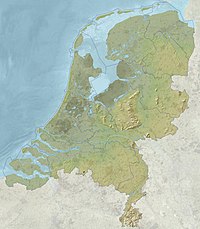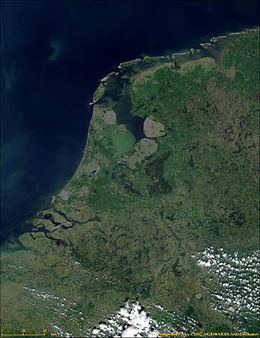|
Geography of the Netherlands
  The geography of the European Netherlands is unusual in that much of its land has been reclaimed from the sea and is below sea level, protected by dikes. It is a small country with a total area of 41,545 km2 (16,041 sq mi)[1] and ranked 131st. With a population of 17.4 million[2] and density of 521/km2 (1,350/sq mi) makes it the second most densely populated member of the European Union after Malta, and the 12th most densely populated country in the world, behind only three countries with a population over 16 million. Consequently, the Netherlands is highly urbanized. StatisticsGeographic coordinates: 52°22′N 4°53′E / 52.367°N 4.883°E The Dutch RD coordinate system (Rijksdriehoeksmeting) is also in common use.[3] For transformation to and from geographical coordinates there is an official procedure RDNAPTRANS™[4] and approximate as well as precise[5] tools available. The west–east coordinate is between 0 and 280 km, and the south–north coordinate between 300 and 620 km. The central point is the Onze-Lieve-Vrouwentoren (Our Lady's Tower) in Amersfoort, with RD coordinates (155,000.00, 463,000.00 m) and geographic coordinates approximately 52°9′N 5°23′E / 52.150°N 5.383°E. Area:[6]
Land boundaries:
Coastline: 451 km (280 mi) Maritime claims:
Climate: temperate; marine; cool summers and mild winters (European mainland), tropical (Caribbean islands) Terrain: mostly coastal lowland and reclaimed land (polders); some hills in southeast  Elevation extremes:
Natural resources: natural gas, petroleum, peat, limestone, iodised salt, sand and gravel, arable land Land use: (2011)
Irrigated land (2007): 4,572 km2 (1,765 sq mi) Total renewable water resources (2011): 91 km3 (22 cu mi)  Natural hazards: flooding by sea and rivers is a constant danger. The extensive system of dikes, dams, and sand dunes protect nearly one-half of the total area from being flooded during the heavy autumn storms from the north-west. Environment – current issues: water pollution in the form of heavy metals, organic compounds, and fertilisers such as nitrates and phosphates; air pollution from vehicles and refining activities; acid rain Environment – international agreements:
LandscapeThe country can be split into two areas: the low and flat lands in the west and north, and the higher lands with minor hills in the east and south. The former, including the reclaimed polders and river deltas, make up about half of its surface area and are less than 1 metre (3.3 ft) above sea level, much of it actually below sea level. An extensive range of seawalls and coastal dunes protect the Netherlands from the sea, and levees and dikes along the rivers protect against river flooding. A recent global remote sensing analysis suggested that there were 1,025 km2 of tidal flats in the Netherlands, making it the 31st ranked country in terms of tidal flat area.[7] The rest of the country is mostly flat; only in the extreme south of the country does the land rise to any significant extent, in the foothills of the Ardennes mountains. This is where Vaalserberg is located, the highest point on the European part of the Netherlands at 322.7 metres (1,059 ft) above sea level. The highest point of the entire country is Mount Scenery (887 metres or 2,910 ft), which is located outside the European part of the Netherlands, on the island of Saba in the Caribbean. The Netherlands is located at mouths of three major European rivers (Rhine, Maas or Meuse, and Scheldt). In November 2016, the Netherlands and Belgium agreed to cede small, uninhabited parcels of land to reflect a change in course of the river Meuse (or Maas, in Dutch). The land swap is to take effect as of 2018.[8] UrbanizationLargest citiesWith their provinces in November 2019:[9]
ClimateThe predominant wind direction in the European Netherlands is southwest, which causes a mild maritime climate, with moderately warm summers and cool winters, and typically high humidity. This is especially true close to the Dutch coastline, where the difference in temperature between summer and winter, as well as between day and night is noticeably smaller than it is in the southeast of the country. Ice days—maximum temperature below 0 °C (32 °F)—usually occur from December until February, with the occasional rare ice day prior to or after that period. Freezing days—minimum temperature below 0 °C (32 °F)—occur much more often, usually ranging from mid-November to late March, but not rarely measured as early as mid-October and as late as mid-May. If one chooses the height of measurement to be 10 cm (4 in) above ground instead of 150 cm (59 in), one may even find such temperatures in the middle of the summer. On average, snow can occur from November to April but sometimes occurs in May or October too. Warm days—maximum temperature above 20 °C (68 °F)—are usually found in April to October, but in some parts of the country these warm days can also occur in March, or even sometimes in November or February (usually not in De Bilt, however). Summer days—maximum temperature above 25 °C (77 °F)—are usually measured in De Bilt from May until September, tropical days—maximum temperature above 30 °C (86 °F)—are rare and usually occur only in June to August. Precipitation throughout the year is distributed relatively equally each month. Summer and autumn months tend to gather a little more precipitation than the other months, mainly because of the intensity of the rainfall rather than the frequency of rain days (this is especially the case in summer when lightning is also much more frequent). The number of sunshine hours is affected by the fact that because of the geographical latitude, the length of the days varies between barely eight hours in December and nearly 17 hours in June. The following table is based on mean measurements by the KNMI weather station in De Bilt between 1991 and 2020. The highest recorded temperature was 40.7 °C (105.3 °F), reached on 25 July 2019 in Gilze-Rijen.[10][11] The lowest temperature in the Netherlands was recorded at Winterswijk on 27 January 1942, when the temperature dropped to −27.4 °C (−17.3 °F).[12]
See also
References
External linksWikimedia Commons has media related to Geography of the Netherlands.
Maps
|
|||||||||||||||||||||||||||||||||||||||||||||||||||||||||||||||||||||||||||||||||||||||||||||||||||||||||||||||||||||||||||||||||||||||||||||||||||||||||||||||||||||||||||||||||||||||||||||||||||||||||||||||||||||||||||||||||||||||||||||||||||||||||||||||||||||||||||||||||||||||||
